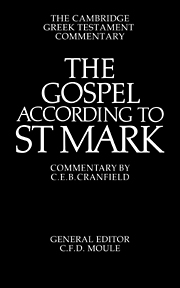Book contents
- Frontmatter
- Preface by the General Editor
- Contents
- List of Abbreviations
- Acknowledgements
- INTRODUCTION
- I AUTHORSHIP, DATE AND PLACE OF WRITING
- II THE CHARACTER OF THE GOSPEL
- III THE THEOLOGY OF THE GOSPEL
- IV TEXTUAL CRITICISM OF THE GOSPELS
- NOTES
- SUPPLEMENTARY NOTES
- REVISED ADDITIONAL SUPPLEMENTARY NOTES
- Addenda
- Index
I - AUTHORSHIP, DATE AND PLACE OF WRITING
Published online by Cambridge University Press: 15 March 2010
- Frontmatter
- Preface by the General Editor
- Contents
- List of Abbreviations
- Acknowledgements
- INTRODUCTION
- I AUTHORSHIP, DATE AND PLACE OF WRITING
- II THE CHARACTER OF THE GOSPEL
- III THE THEOLOGY OF THE GOSPEL
- IV TEXTUAL CRITICISM OF THE GOSPELS
- NOTES
- SUPPLEMENTARY NOTES
- REVISED ADDITIONAL SUPPLEMENTARY NOTES
- Addenda
- Index
Summary
EARLY TRADITION
The earliest extant statement about the Gospel according to St Mark is a quotation in Eusebius (H.E. m. 39) from a lost exposition of the Lord's sayings written by Papias, bishop of Hierapolis, about A.D. 140. It may be translated as follows:
This also the Elder said: Mark, who became Peter's interpreter, wrote accurately, though not in order, all that he remembered of the things said or done by the Lord. For he had neither heard the Lord nor been one of His followers, but afterwards, as I said, he had followed Peter, who used to compose his discourses with a view to the needs [of his hearers], but not as if he were composing a systematic account of the Lord's sayings. So Mark did nothing blameworthy in thus writing some things just as he remembered them; for he was careful of this one thing, to omit none of the things he had heard and to make no untrue statement therein.
The first sentence at any rate—and this is the vital one— is a quotation within a quotation and gives us the testimony of an older contemporary of Papias who is probably to be identified with the Elder John mentioned by him in another passage which Eusebius has just quoted. It is thus evidence of what was believed in the province of Asia at the beginning of the second century.
- Type
- Chapter
- Information
- The Gospel according to St MarkAn Introduction and Commentary, pp. 3 - 9Publisher: Cambridge University PressPrint publication year: 1959



